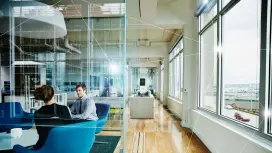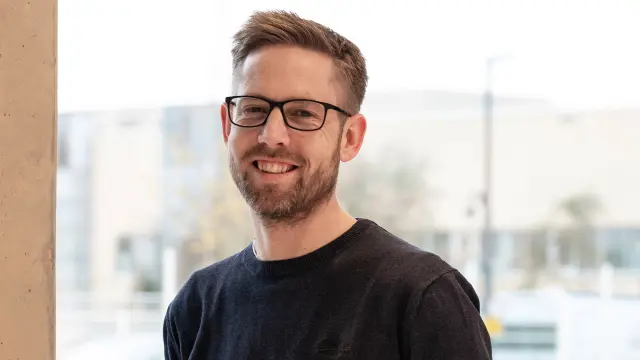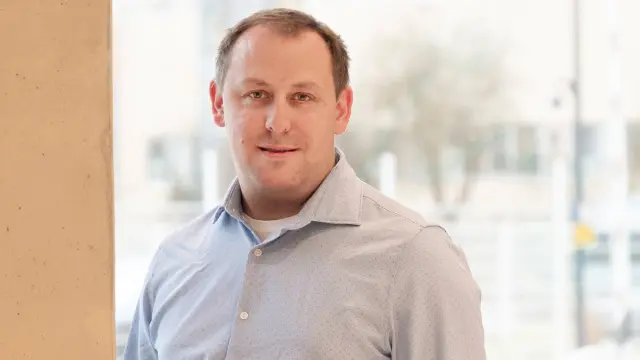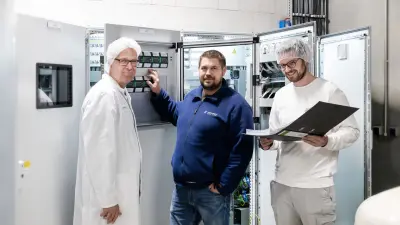A building automation solution for ideal cleanroom conditions in pharmaceuticals production
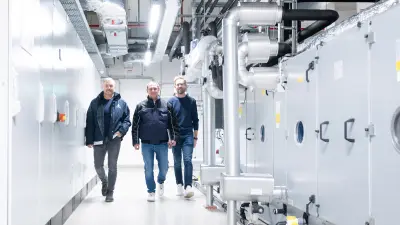
Pharmaceutical service providers have to comply with the highest standards for aseptic filling of drugs. The company of Vetter in Ravensburg, Germany therefore relies on precise building automation solutions from Hörburger GmbH for controlling the complex ventilation systems with full climate control that are installed in its cleanrooms in order to meet the strict requirements of the authorities.
Vetter, a provider of services for pharmaceuticals, is expanding its aseptic filling capacities. In late 2024 it finished installing the first three of seven planned cleanrooms in the production building at its Schützenstrasse (SST) site in Ravensburg. Hörburger GmbH, a subsidiary of Bosch Energy and Building Solutions, developed and installed an automation solution for controlling pressure, temperature and humidity in the cleanrooms. In and around Ravensburg alone, Vetter has three production facilities where more than 200 million units of injectable medications are filled and packaged each year for leading pharmaceutical and biotech companies. “Producers of pharmaceuticals worldwide rely on our know-how,” says Markus Joos, who is in charge of systems and service media at Vetter, one of the world’s leading providers of services for aseptic production of drugs. “Sterile injectables have to be 100% free of impurities that might harm patients. We adhere to a special, technically highly complex production process to ensure this high level of sterility.”

The conditions inside a cleanroom are highly complex. But it was a challenge that we were happy to accept.

Cleanrooms: the premium class in building automation
In cleanrooms used to aseptically fill medications for the pharmaceutical industry, it is essential to constantly monitor and precisely control the temperature, relative humidity and air pressure. This is vital in order for Vetter to comply with the stringent GMP (good manufacturing practice) rules and meet the sterility and quality requirements of the corresponding authorities worldwide, such as the United States Food and Drug Administration (FDA).
Constant cleanroom conditions: the prerequisite for aseptic filling
One challenge is maintaining constant conditions in the cleanrooms, because deviations from them can endanger product quality. Hörburger’s team programmed the building automation system to control the ventilation system in accordance with the customer’s requirements, some of which are very strict. High-sensitivity sensors in the cleanroom continuously measure the relevant parameters. The ventilation system’s controller immediately responds to any fluctuations to consistently keep conditions within the predefined narrow tolerances. A building management system installed by Hörburger GmbH enables Vetter’s team of operators to view all of the data live on mobile devices.
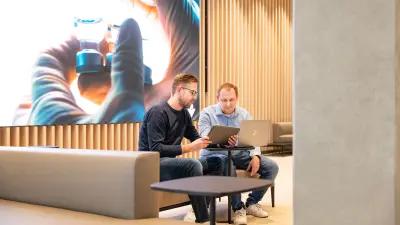
Decontamination: a challenge for the ventilation systems
Decontamination of the cleanrooms – accomplished by cleaning them with hydrogen peroxide (H₂O₂) – is a special case. It poses very exacting requirements for coordinating the ventilation systems. Pressure differences during this complex, multi-hour process must be kept constant, and at the end the overpressure required for production has to be precisely restored. While implementing the system, Hörburger’s building automation team carried out comprehensive simulations and tests to optimize the ventilation system and programmed the automation software to keep the pressure stable in the cleanrooms.
Deviations promptly indicated
Software is referred to as “frozen” when important parameters are locked in past a certain point to prevent them from being altered while validation is ongoing. This ensures the software’s stability, reliability and conformity prior to its deployment in cleanroom environments. If the measured values exceed the permitted tolerances, an early warning system quickly alerts Vetter’s team of operators so they can immediately intervene and investigate the error messages to prevent failures. The sensors send a preliminary warning to the management system, and the responsible personnel can use their tablet computers to pinpoint the affected sensors on the system’s site plan. The most important components – such as frequency converters or sensors for controlling room pressure – have also been redundantly implemented.
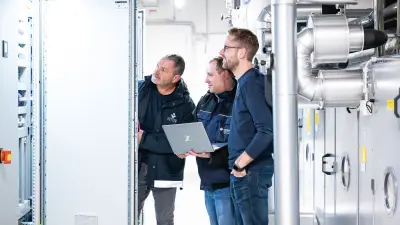
Everything from planning to commissioning in one hand
The collaboration between Vetter and Hörburger has grown over the years. “We’ve been working for the company since 2017,” says Markus Steuer, a project and sales engineer with Hörburger GmbH. “We started with smaller projects, but as far back as 2018 started handling the planning and implementation of building automation systems for their new administration building in Ravensburg, which was completed in 2020. In 2024 we finished the control systems for three cleanrooms, and more will follow over the next few years. It’s an ongoing process. We’re now responsible for all of the building automation systems at their Ravensburg site. Vetter wants its providers to be available quickly when needed, and we’re based in Waltenhofen just 75 kilometers away. They also value our ability, as providers of complete solutions, to look outside the box and find solutions for requirements that go beyond our particular specialization. It’s important to our customers that we handle all facets of building automation, from planning all the way to installation – which is naturally no problem for our team,” asserts Markus Steurer.
Deviations can lead to losses
Demanding requirements must met for planning and executing a project and finally taking it live. “We have to meet very strict standards in terms of sterility and patient safety. Every batch filled has to meet production requirements defined by the authorities. The partners we contract to handle the technical processes of our cleanrooms therefore also have to meet corresponding quality specifications. And we can count on Hörburger to deliver,” explains Markus Joos. If any deviations occur during aseptic filling of pharmaceuticals, they can disqualify an entire batch and prevent it from being delivered to the manufacturer. To avoid running risks of this kind, Vetter relies on highly precise building automation, strict quality checks and comprehensive monitoring systems. Extremely sensitive high-precision sensors are installed in the cleanrooms and corresponding ventilation systems. The goal is to capture as much measurement data as possible on temperature, moisture and pressure. Since these parameters can affect product quality, it is essential to continuously and reliably record them. “The data on ongoing operation converges in a building management system that we’ve installed and configured, where it’s visualized in real time. This live data stream seamlessly keeps Vetter’s team informed of the conditions inside the cleanroom. What’s more, it can be intelligently analyzed in order to, for example, quickly spot any malfunctions”, explains Markus Steurer.
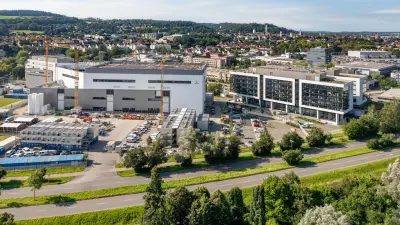
About Vetter
Vetter Pharma-Fertigung GmbH & Co KG based in Ravensburg, Germany is a leading “contract development and manufacturing organization” (CDMO) in the pharmaceutical industry. Founded in 1950, this provider of pharmaceutical services now operates facilities in Germany, Austria, the United States and Asia with a total of more than 7,000 employees. The company has ten facilities in and around Ravensburg alone, with over 20 commercial filling lines in which vials, syringes and cartridges are filled with liquid or freeze-dried products. The family-run enterprise does not produce any active ingredients itself.
© Vetter Pharma International GmbH
Temperature, moisture and pressure influence conditions in the cleanroom

The building automation solution from Hörburger GmbH keeps the sensitive system comprising temperature, air pressure and moisture in balance in Ravenburg’s cleanrooms. During the planning stage, all building systems relevant to ventilation were taken into account. Installation of the switch cabinets at the customer’s facility in Ravensburg was the final step of a process that began with project development and planning and continued with building the cabinets and performing appropriate quality tests at Hörburger in Waltenhofen. “In terms of complexity and effort, it’s in a whole different league from a normal system,” says Florian Thunitgut, a project manager at Hörburger GmbH, about the time-consuming on-site work that was required to implement the system. “It only takes a few days to install a ventilation system in a school, but a cleanroom keeps the team busy for months.” Several weeks are spent testing the parameters of temperature, moisture and pressure in a not-yet-sterile cleanroom environment and tweaking the software to adapt it to a wide range of parameters – until, finally, the building automation system is programmed to perform reliably under production conditions.
For the final inspection, the cleanroom is sealed and put through its paces during a trial under sterile conditions. To maintain the pressure differential between the cleanroom and the attached locks, the air feed rate is kept constant while the exhaust air is managed with volume flow controllers.
The system’s accuracy protects it from failure
“It’s crucial for the system to be accurate. Heating and cooling media, among others, affect the ventilation system. Whether or not persons are present barely makes a difference, since cleanrooms require a high air exchange rate. But the air temperature has to be controlled to consistently keep it within a narrow tolerance band. Our expertise enables us, among other things, to program the controllers so they also quickly and correctly respond to external temperature fluctuations. Instead of oscillating, they have to immediately stabilize and remain at a constant level,” explains Florian Thunitgut. Even strong storms can influence them, so the software also has to be able to compensate for phenomena of this kind. “Software that we specially programmed ourselves takes all of these events into account to consistently ensure the right conditions inside the cleanroom.”
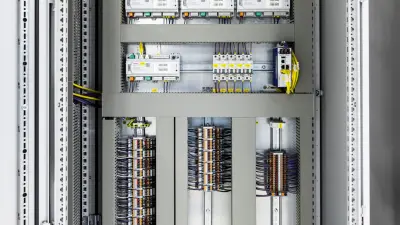

Cooperation is growing – additional projects planned
Vetter needs partners that precisely and dependably work according to its precise specifications. Filling of containers with pharmaceuticals has to be done reliably and as well as possible while following agreed schedules. “It’s important to us to know that our partners can be here on site quickly when we need their support. Which is why we attach importance to collaborating with regional companies like Hörburger. Over the course of years, they familiarize themselves with our requirements and standards. This way we know that we can count on getting high quality from them,” says Markus Joos. Markus Steuer adds that “we’re constantly on site and can also immediately replace a sensor if required.”
Hörburger GmbH is now responsible for all of the building automation systems at the site. The companies’ partnership has grown over time, and Hörburger sees itself as Vetter’s long-term partner. It will be involved in programming additional cleanrooms for several more years. In any case, Vetter never stands still. This provider of pharmaceutical services is growing organically to meet the increasing demand for commercial production of approved medications for the global pharmaceuticals market.
